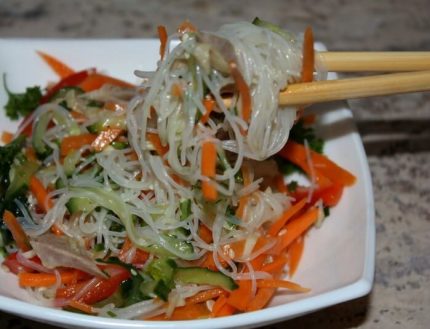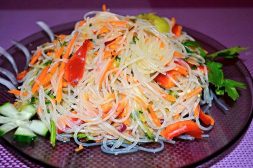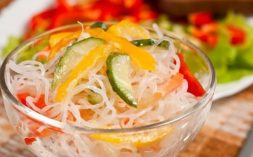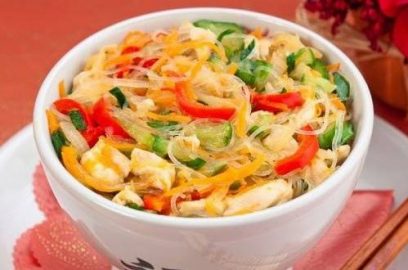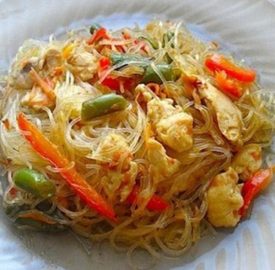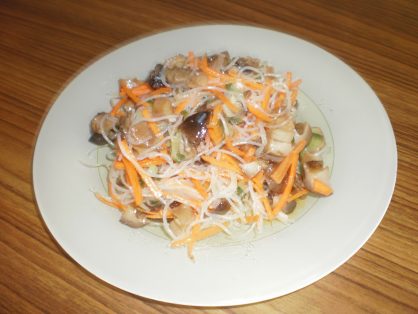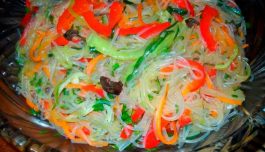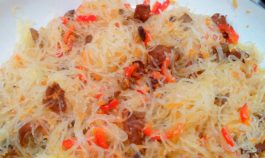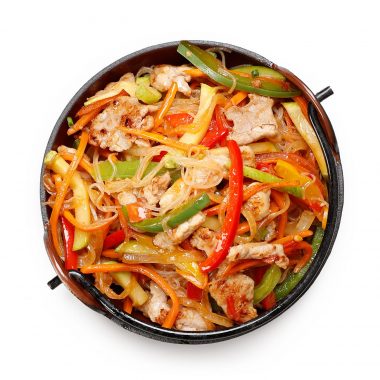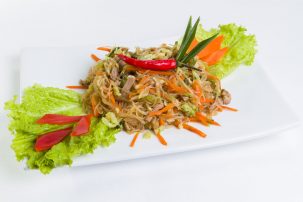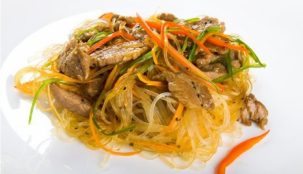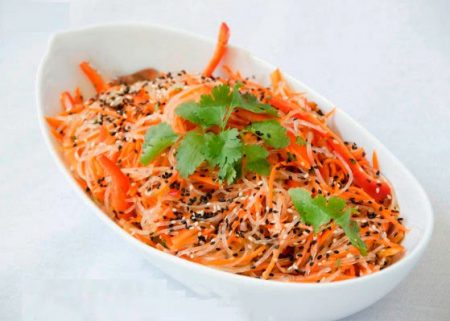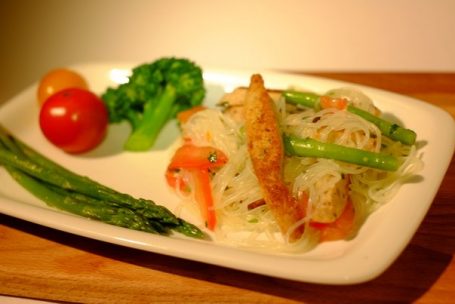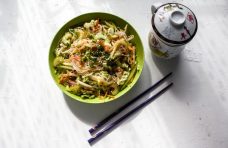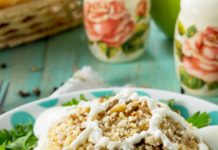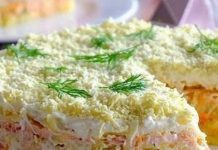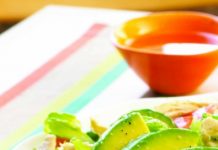Mayonnaise salads are unlikely to ever leave the table of a person who grew up in the territory of the country of the Soviets. “Olivier” and “Mimosa” will be constantly poured with splashes of champagne to the chiming clock, and “Spring” under the barbecue for May will not replace anything. But in the daily diet I want something more healthy and dietary. A great solution would be a salad with funchose and vegetables. This dish came from Asian cuisine and has long been loved by many housewives. Behind an unusual word for hearing is an elegant, translucent, finest noodle made from starch of various plants.
Material Content:
- 1 The composition of funchose
- 2 Product Usefulness
- 3 How and how much to cook noodles
- 4 Salad Recipe with Funchose and Vegetables
- 5 Salad with funchose, vegetables and chicken
- 6 Salad with funchose, vegetables and shrimp
- 7 Light salad with funchose, vegetables and mushrooms
- 8 Salad with funchose, vegetables and asparagus
- 9 Salad with funchose, vegetables and pork meat
- 10 Korean style spicy mushroom salad with vegetables
- 11 Summer salad with funchose, vegetables and rape
- 12 Calorie table for all salads
The composition of funchose
Disputes do not subside about which country the authorship of funchoses belongs to. It is sometimes called Chinese, then Japanese, sometimes even Indian ... Let us dwell on the definition of "Asian" so as not to offend anyone. You must have met such noodles in supermarkets. It is twisted into “nests” or folded by loose briquettes, grayish-white, brittle, it smells subtle like nuts or not at all. By the way, if under the label with the inscription "funchoza" you see a product that does not meet this description, refrain from buying - you are being deceived.
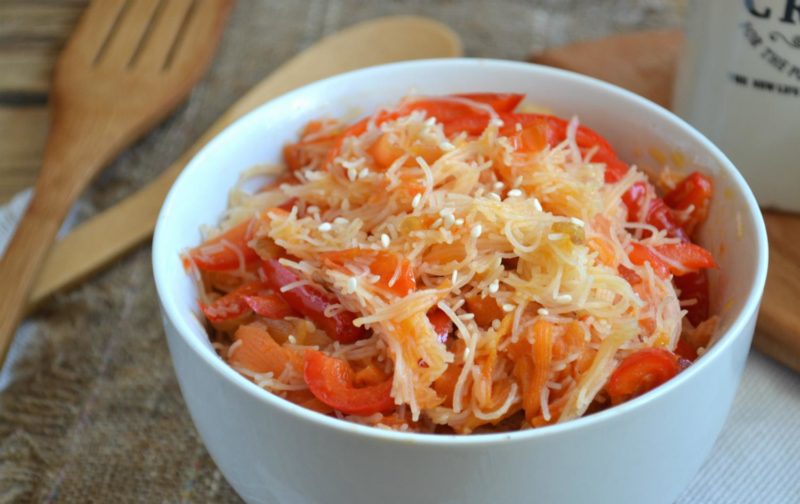
Rice noodles are often called funchose, but this is a gross mistake. The latter is made from rice flour, visually resembles ordinary noodles (flat, long or folded several times) and when cooking becomes completely white. Funchoza is made from legume starch and it is thanks to it that cooked noodles acquire an interesting transparency. For this, funchose is often called glass noodles.
Real bean noodles are rich in such substances:
- vitamins (tocopherol, folic acid, riboflavin, nicotinamide and others);
- essential amino acids;
- trace elements (in descending order - sodium, phosphorus, selenium, potassium and others);
- fatty acid.
The calorie content of the “glass” filaments does not exceed 320 kcal, despite the fact that they are 85-90% composed of complex carbohydrates, contain up to 10% water and only a fraction of a percent of fats and proteins.
Product Usefulness
Real funchose is many times more useful than rice noodles and regular pasta. But in order not to be disappointed, you will have to read the information on the label well. Only starch made from mung bean gives glass noodles the best properties. Any other affects the taste, benefits and even safety of the product. Achieving characteristic transparency, unscrupulous manufacturers do not disdain the addition of dangerous "chemistry".
- Funchoza is a product that, without fear, can be eaten by dieters. The calorific value of such noodles is even slightly lower than that of buckwheat - the favorite cereal of all losing weight. In addition, it is full of complex carbohydrates, and they do not give a feeling of hunger for a long time, and almost no fat.
- An essential detail - real bean starch noodles can be found daily in the diet of people with diabetes. Such starch does not break down to glucose. But carefully read the label, because funchose is already successfully made from potato and corn starch, and they have other characteristics.
- You can also use “glass noodles” for people with chronic diseases of the digestive system. One has only to carefully approach the choice of sauces.
- Funchoza can be eaten without fear by people suffering from allergies. There is no gluten in this product.
- Group B vitamins make it possible to add legumes to the list of antidepressants that have a beneficial effect on the state of the nervous system.
- Complex carbohydrates provide energy for a long time, which is ideal for those who plan to go to the gym. A salad with such noodles is a great meal for lunch before training.
How and how much to cook noodles
In the preparation of bean noodles there are no difficulties and magic tricks. Even a completely inexperienced mistress or a delinquent spouse can cope with such a task.
- Before cooking, pay attention to the diameter of the cross section of the noodles. If it is very thin, up to a millimeter in cross section, then it will not even need to be boiled. It is enough to drown in boiling water in a deep bowl, cover and leave for no more than 5 minutes. Thicker threads are boiled like banal pasta - dipped in boiling water for 5-8 minutes. Usually information on the cooking time is provided by the manufacturer on the packaging.
- Observe proportions. For 100 grams of bean filaments, it is optimal to take a liter of water. Noodles are quite light and are sold in packages of 200-500 grams.
- Unlike other pasta, rice noodles, the water in which the funchosa is cooked is not salted and other spices are not added to it. Ready-made yarns should not have a pronounced taste, this function completely falls on sauces and other components of dishes.
- When cooking, it is good to add vegetable oil to the water. Anything will do, but the most authentic is sesame.
- Bean threads are considered finished when they acquire softness and transparency, but are still quite elastic. It is impossible to digest or leave them after cooking in water - they stick together, become like lumps of an incomprehensible substance and it is already impossible to eat them.
- After cooking, funchose is transferred to a colander or sieve. If necessary, rinse with water.
It’s better to eat bean noodles even warm. Therefore, try to add it to salads immediately before serving.
Cooking with funchose for the future is impossible. This product must be eaten immediately before it has lost its palatability and attractive aesthetic appearance.
Salad Recipe with Funchose and Vegetables
Incredibly beautiful salad of equally thinly cut fresh vegetables and translucent noodles.It’s good when at your place there is a special grater, which is usually used for making Korean salads. If not, sharpen the knife sharper - we will need to cut the vegetables as thin as possible.
How to make a salad funchose with vegetables?
We will need 100 grams of the main product, as well as one each:
- cucumber
- bell pepper (excellent, if you take half of the red and yellow);
- carrots.
For dressing, take the taste of garlic, a tablespoon of vinegar (preferably wine) and as much pure soy sauce and familiar oil.
- Prepare funchose as described above.
- Peppers clear of stalks, seeds, cucumbers, remove the "ass", check if the skin is bitter, peel the carrots.
- Shred all vegetables with a thin straw.
- In a bowl, mix the ingredients, season with the sauce, squeeze the garlic.
- If desired, you can supplement the finished dish with your favorite greens: cilantro, lettuce, arugula.
Salad with funchose, vegetables and chicken
A more nutritious version of the salad with glass noodles. It is suitable for those who are on a diet, or those who do not know what to choose for dinner after returning from training.
For 100 grams of funchose, prepare the ingredients:
- half of bell pepper and carrots;
- one onion;
- a quarter kilo fillet;
- grams to 200 string beans.
Funchose salad with chicken and vegetables is best served with classic soy sauce mixed with rice vinegar with garlic. Salt and pepper to taste.
- Cut the meat into thin sticks, add spices and fry in hot oil until tender.
- Chop the pepper with straws, onion with the halves of the rings, grate the carrots.
- Fry beans and onions until half cooked, add pepper and carrots, salt.
- Boil the funchoza or just scald it with boiling water (see the preparation method on the packaging).
- Put all the ingredients in a deep bowl, season with sauce and garnish with greens if desired.
You can eat salad and still warm, and after an hour or two after cooking.
Salad with funchose, vegetables and shrimp
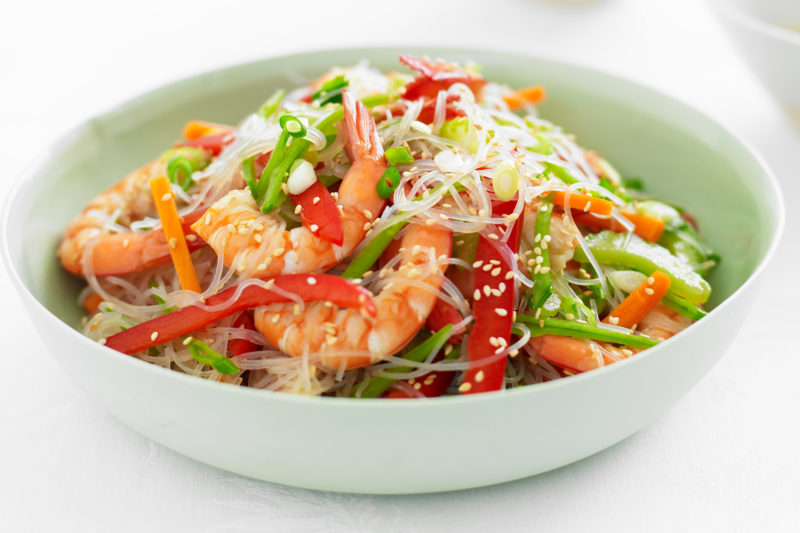
Since funchose is very widely used in Japan, seafood is the second most popular ingredient in salads with it, after vegetables. Shrimp is perhaps the most familiar and beloved component of all.
We prepare a salad of 100 grams of transparent noodles and products:
- a dozen large shrimps or 300 small grams;
- half of Bulgarian peppercorns and carrots;
- garlic and green onions to taste;
- sesame.
For dressing, take soy sauce without additives and sesame or other available oil.
- Cook the funchozu, as indicated on the packaging, discard in a colander.
- Cut the vegetables into strips or three on a coarse grater, boil the shrimp, remove the shells.
- Heat the oil and pass the vegetables until cooked.
- We put ready shrimps in a pan to the vegetable mix, chopped onion feathers, squeeze the garlic.
- Our salad is almost ready. It remains to add funchose, season it and sprinkle with sesame seeds.
This dish goes well with both warm and cold snacks. Before serving, garnish with crumbled parsley or cilantro.
Light salad with funchose, vegetables and mushrooms
This salad can include any vegetables. The set offered in the chicken salad recipe will be very good. Vegetables can be left as fresh or fry them together with mushrooms. Everything rests on the imagination and preferences of the hostess. An interesting dish with cherry tomatoes is also a beautiful, juicy, piquant and certainly not beaten option.
For 100 grams of bean noodles you will need:
- 150 grams of any mushrooms, can be champignons;
- as much cherry tomato;
- pieces of 7-8 lettuce;
- sesame.
We will season the salad with teriyaki sauce (2.5 tablespoons). If you wish, you can include a little oil with the addition of classic soy sauce.
- Prepare the noodles in the usual way and drain the water.
- Cut the tomatoes into quarters, mushrooms - in strips, tear the lettuce leaves into pieces convenient for consumption.
- Heat a little oil in a pan and quickly fry the tomatoes.Remove and place on napkins to absorb oil.
- Fry the mushrooms in the same pan. Here you can immediately throw sesame seeds or sprinkle them with a finished dish later.
- Put all the ingredients in a bowl, season with teriyaki, soy sauce and butter. Spice up.
Salad with funchose, vegetables and asparagus
Asparagus is often added to various salads, but few people know that this plant has a rather powerful diuretic effect. By adding asparagus shoots to dinner, you can avoid swelling, which will come in handy for pregnant women, people working at the computer, and those who are on a diet.
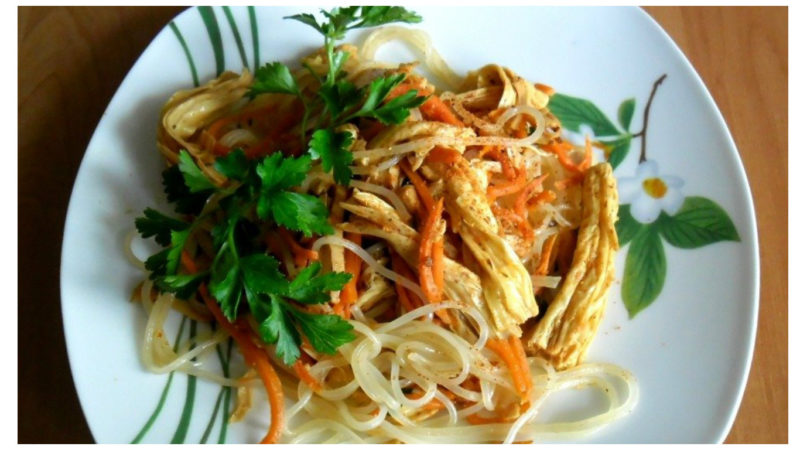
Keep in mind that this is a plant, not what we usually call Korean or soy asparagus.
For salad, traditionally take 100 grams of funchose and prepare the following products:
- a pound of asparagus;
- carrots and cucumber;
- sesame;
- coriander, if you like.
The sauce this time has to be made more difficult. To do this, take 2 tablespoons of oil (you can olive or sesame) and the same amount of soy sauce, sugar, a teaspoon and a quarter spoon of Tabasco or red pepper.
- We clean the asparagus and then blanch in salted water and sugar for several minutes.
- At this time, we cut into strips carrots and cucumber.
- Boil the funchozu or simply pour boiling water, depending on the diameter of the cross-section of the threads.
- We lay out all the ingredients in a deep container, add the sauce, mix and sprinkle with sesame seeds on top.
You can cook the exact same salad from soy asparagus (it is called fuju). To do this, first break it and soak it overnight in salted water. Blanch is not necessary, in the morning just cut the fuju in convenient slices and mix with all the ingredients.
Salad with funchose, vegetables and pork meat
It is best, of course, to cook such a salad with pork, but it will not lose much if for some reason you want to replace it with chicken or beef. To make the dish more dietary, make it based on turkey.
For 100 grams of funchose, prepare the following components:
- 300 grams of selected meat, preferably pork;
- 3 medium onions;
- bell pepper;
- 3 eggs;
- carrot.
Teriyaki is good for dressing a funchose salad with vegetables and meat.
- Cut the meat, pepper and carrots into thin strips, and onions with quarters of rings.
- Fry the onions in a pan, add pepper and carrots.
- Transfer meat to vegetables and fry until cooked until half an hour. Salt and pepper 10 minutes before completion.
- Boil the funchoza, drain the liquid and transfer to a deep bowl.
- Beat the eggs, salt and pour the resulting mass into a pre-oiled pan.
- Fry the egg pancake on both sides, remove from the dishes, cool and cut in the same slices as the meat.
- Add pork with vegetables and egg pancake to funchose, season with sauce.
This amount of salad is enough to feed a family of three or four people with a light dinner. Complete it with a mix of fresh vegetables.
Korean style spicy mushroom salad with vegetables
It is ideal to use Korean-style vegetables in this dish. They are best purchased ready-made at special stores or points in the market. If you already have experience in cooking vegetables in this way, you can make them yourself.
For a salad per 100 grams of funchose, the following components will be required:
- half of daikon radish and carrots in Korean;
- half pepper paprika;
- soy meat 200 grams.
Korean style salad dressing of funchose with vegetables is not too complicated to cook well. Enough 1-2 tablespoons of pure, without additives soy sauce and a little lemon juice.
- Cook the noodles as written on the package. Pour into a colander to remove water.
- Heat a little oil in a pan and fry vegetables in it.
- Soak soy meat in hot water and, after about 7 minutes, add it to the vegetable mix.
- Fry all the ingredients together for another 5 minutes.
- Transfer the vegetables with meat and the finished funchose into a bowl, mix, add the sauce.
Such a salad is ideal to use as cold as an appetizer, and not the main dish.
Summer salad with funchose, vegetables and rape
Rapana is a great choice for a funchose salad. You can prefer only them or prepare a mix of seafood. Mix well chopped squid rings, chopped octopuses, a few shrimps and a handful of raps.
To 100 grams of funchose, take the following set of products:
- up to 200 grams of shellfish;
- bulb;
- 4 cm of ginger root;
- a small slice of chili pepper;
- a pair of Bulgarian peppers (preferably multi-colored);
- zucchini;
- 2 cloves of garlic.
The sauce for this already multi-component dish can be taken complicated. 50 ml of soy, a spoonful of fish and oyster. If you don’t have something, don’t worry. Season only with soy sauce and add vegetable oil and a little lemon juice.
- Fry the raps for a couple of minutes, then muffle the fire and simmer until cooked.
- At this time, cut the onion in half rings, finely chop the garlic, ginger and chili. Thin sticks shred peppers and zucchini.
- We pass the onions with garlic, and after a couple of minutes we send the rest of the vegetables to them. Fry the whole vegetable smoothie for at least 5 minutes.
- We prepare funchose, put it in a deep dish.
- Add glass noodles to almost ready-made vegetables, season salad and crush with a pinch of turmeric.
- The line reached the raps. Spread them in a pan, mix well. We muffle the fire and extinguish for an additional 10 minutes.
If you are not sharp enough, add dry red pepper - this salad will benefit from this neighborhood.
Calorie table for all salads
Funchoza is a dietary product, but seasoned with delicious sauces, and with the addition of meat components, it immediately becomes a rather high-calorie dish.
In order not to have to think about whether or not to eat this or that salad while dieting, refer to this table.
| salad | calories, kcal |
|---|---|
| With vegetables | 461 |
| With vegetables and chicken | 766 |
| With vegetables and shrimp | 690 |
| With vegetables and mushrooms | 695 |
| With vegetables and asparagus | 553 |
| With vegetables and pork | 1500 |
| With vegetables "in Korean" | 712 |
| With vegetables and raps | 691 |
Remember that the rate of calories per day is dependent on lifestyle and age. For women:
- from 19 to 25 years: 2–2.4 thousand kcal;
- up to 50 years: 1.8-2.2 thousand kcal;
- older than 50 years: 1.6-2 thousand kcal.
In men, the norm is 200-500 kcal higher. If you are on a diet, keep in mind that these figures need to be reduced by 100-200 kcal.
Funchoza - the product is not yet familiar to us. But do not be afraid of experiments! This noodle itself is almost tasteless, because it is saturated with aromas and relish of the other ingredients of the finished dishes. It is unlikely to make a mistake and make it tasteless, because when you see a package of funchose in the store, feel free to take it! You will surely find what to cook with it.


